The last of mixed cruisers:
The USS Newark was a mixed cruiser (steam and sail), and because of this one of the last of her kind. She was very close to the USS Chicago and the last of the “ABC” cruisers.
The ‘ABC’ were the USS Atlanta, Boston, and Chicago, among the first cruisers in US history. To be true, the Newark was the eighth protected cruiser. So this was a good example of the “new navy” by contrast with the civil war suviving ships navy called the “old navy”. In appearance though, these cruisers still had mixed features, a full rigging in alternative to steam power (deployed here as shown in the illustration below) which makes the Newark and other cruisers of the 1880s like transitional and conservative vessels. Her conception was so dated by the time of the beginning of the century, that she was decommissioned in 1912 and don’t even saw the conflict, like the others.
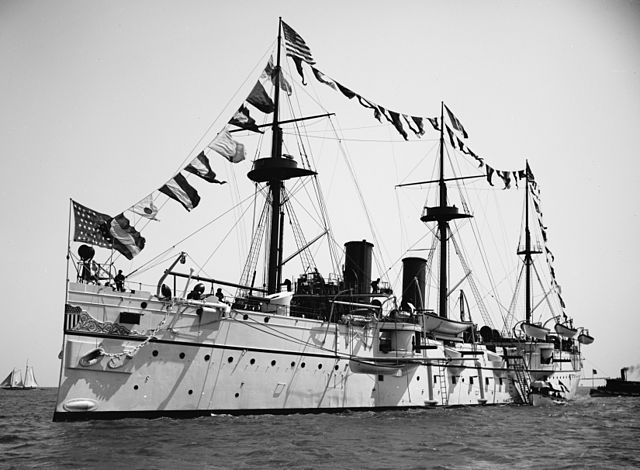
The previous USS San Francisco (1889)
Development and construction
Le USS Newark was a collaborative effort started in 1885: When it was felt that that previous design was inadequate, the Bureau of Construction and Repair and Bureau of Steam Engineering worked together on specifications issued by a special advisory board, directly under supervision of Secretary of the Navy William C. Whitney, which “short circuited” the Naval Advisory Board. The effort moslty concentrated in the need of having a main armament of twelve 6-inch guns in sponsons, despite the objections of Rear Admiral Edward Simpson, which though it was impossible to concentrate 8-inch guns in sponsons on a ship of such constrained displacement. Also the decks were fully protected in accordance of European standards of the time.
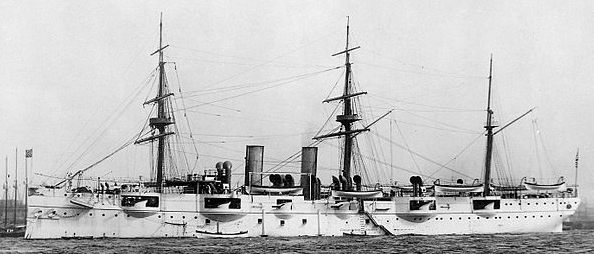
USS Newark in 1891, port side
Design
Propulsion
The power depended on four coal-fired locomotive boilers producing 160 psi or 1,100 kPa, the steam being managed and amplified by two horizontal triple expansion engines for a gross total of 8,500 ihp (6,300 kW). There were two shafts adnd top speed was 18 knots (33 km/h; 21 mph). A ridiculous figure when compared to 1930s cruisers, but cruisers were then seen mostly as substitutes for battleships in battle lines. More importantly the USS Newark still used a full sail rig, mostly used only when conditions were ideal, to increase cruising range. But this cumbersome survivance was discarded later. The ship nevertheless had a supply of 400 tons of coal, giving a designed range of 3,922 nautical miles (7,264 km or 4,513 land miles) at ten knots or 19 km/h (12 mph). This normal provision could be excpetionally increased in time of war to 850 tons, giving a range of 8,333 nmi (15,433 km or 9,589 miles).
Armament
Efforts went to increase the main artillery arc of fire, and eventually the provison was made of twelve 6-inch (152 mm)/30 caliber Mark 3 guns, all in sponsons. It looks odd to naot having at least one major gun mounted on deck for and aft, but it was still common pratice at the time to concentrate the arillery for broadside in battle lines. Nevertheless, with a 90° arc, four guns can fire in chase or retreat. Secondary armament comprised four 6-pounder (57 mm (2.2 in)) guns, four 3-pounder (47 mm (1.85 in)) Hotchkiss revolving cannon, two 1-pounder (37 mm (1.5 in)) Hotchkiss revolving cannon and four .45 caliber (11.4 mm) Gatling guns to deal with torpedo boats. For close quarter duels, six 14-inch (356 mm) torpedo tubes were provisioned in the design. However none was mounted.
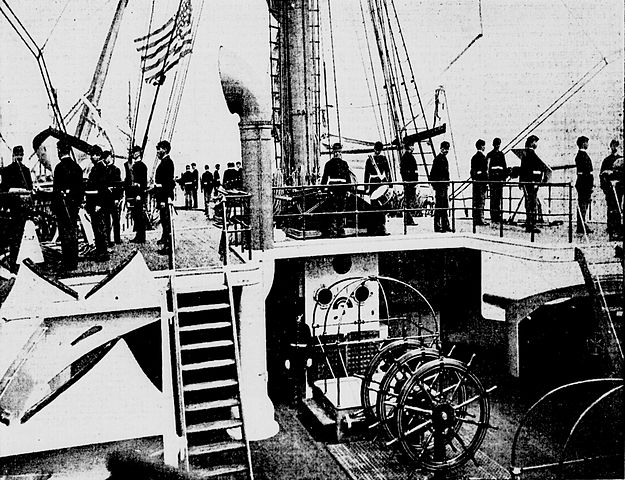
Newark’s own crew manning the auxiliary deck QF guns. The old wheels, masts and rigging reminds the “old navy” tradition.
Protection
The Newark was a protected cruiser, which implied minimal protection against light ships like TB destroyers and light cruisers, not on the level or an armoured cuiser which received the same protection in thickness roughly than the caliber of her main guns. In fact the gun shields were about 2 in (51 mm) thicks, and the conning tower 3 in (76 mm). However the innovation was in a complete armored deck up to 3 in (76 mm) with sloped sides and aft. This thickness was down to 2 in (51 mm) amidships and forward, a significant improvement anyway from the 1.5 in (38 mm) partial deck of USS Chicago and previous ships that were optimized for medium range broadsides in flat trajectories raher than long range duels in parabolic trajectories.
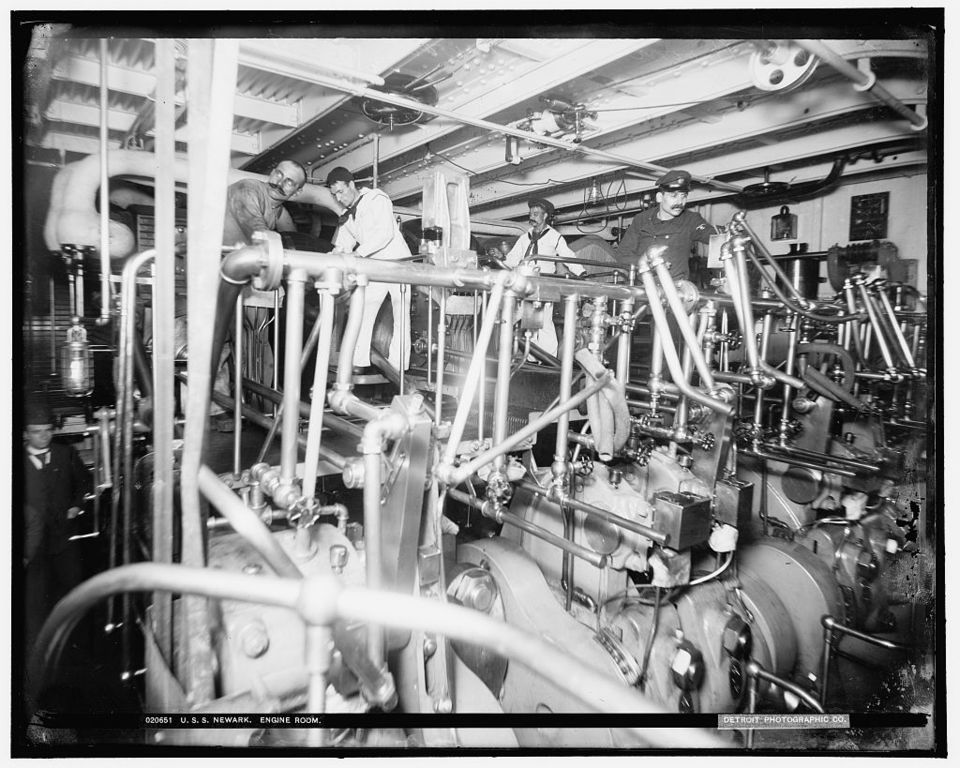
USS Newark engine room
Career: From launch to the 1898 war
The Newark was started on 12 June 1888 at Cramp & Sons in Philadelphia, launched, 19 March 1890, the ceremony bottle being crushed by Miss Annie Boutelle. She was completed and commissioned on 2 February 1891. Her first assignment was the Atlantic coast, where she drilled and exercized for ten months before joining Norfolk Nyd for some early service adjustments. She went on 11 March 1892 to the North Atlantic Squadron, then sailed to the West Indies, Caribbean, and was made flagship of Rear Admiral Andrew E. K. Benham when taking command of the South American squadron. Se tne went to Spain for Columbus discovery ceremonies, then Genoa, the Adriatic, and back to Cuba and Hampton roads, then New York and Quebeck, until joining Norfolk. She then departed for Rio de Janeiro and stayed until early 1894, then sailed for South Africa where she stayed for two years. In 1896, USS Newark went back to the North Atlantic Station. She was decommissioned at Norfolk, 6 March 1897 and went through extensive overhaul.
From the 1898 war to the end
In 1898, 13 June, she departed for Key West and then joined the blocus of Cuba. She shelled the port of Manzanillo on 12 August and accepted the city’s surrender. After the battle of Santiago de Cuba, she finished off the burning wrecks of Spanish ships. Then she went back to New York on 26 November 1898, the departed again on 23 March 1899 for the Sourh American squadron. There, she was called to join San Francisco harbour via the Good Hope cape, and from there departed for the philippines, after coaling at Port Low, Chile. She arrived in Cavite via Honolulu on 25 November and supported US troops actions in the region. During the philippine-American war she was stationed at Vigan, Luzon, then Aparri where she received on 10 December the surrender of three insurrection groups.
From there, on 19 March 1900, she sailed again for Hong Kong, to escort USS Monadnock on 22 March back to Cavite. She also sailed for Yokohama under command of Rear Admiral Louis Kempff, second in command of the Asiatic squadron. She then sailed for China when the Boxer rebellion erupted at Peking. She arrived at Tientsin on 22 May and participated in the operations on Taku and Chefoo, before sending landing parties to Vice Admiral Edward Hobart Seymour relief experdition to Peking. Afterwards, USS Newark was back to Kure and then Cavite where she was the flagship of theSenior Squadron Commander in the Philippines.
She went back to Boston in 1901 via Hong Kong, Ceylon and Suez. She was decommissioned briefly until 3 November 1902, before sailing under orders of Commander Richard Wainwright to the West Indies again. She went back for drydock at Norfolk in 1905 and resumed service on the West coast until returning home waters, being affected as training ship for the United States Naval Academy at Annapolis. She trained for some time, and then landed a Marine detachment at Cuba in September. After 1906 she was decommissioned, then went back into service in 1907 with the New York Naval Militia, and was in Naval Station at Guantánamo Bay from 1908 to 1912. She was back to Norfolk and placed in reserve on the 31 of that year. Decommissioned on 16 June 1912 and stricken from the Navy List on 26 June, she however not ended her life completely.
A second life as a civilian ship began when she was turned over to the Public Health Service. There, she was used as quarantine hulk for the Providence Hospital (Rhode Island) and went to transferred to New York during WW1 for the same purpose as an annex of the Naval Hospital of Newport. She was back to Providence from May 1919 up to 7 July 1926 and was returned to Navy Department to be sold for scrap.
Specifications |
|
| Dimensions | 94.95 x 14.99 x 5.69 m (6.91 m max) or 328 ft oa x 49 ft x 18-22 ft 8 in |
| Displacement | 4,083 long tons (4,149 t) Standard |
| Crew | 34 officers and 350 sailors |
| Propulsion | 2 shafts, 4 boilers Babcock et Wilcox, 2 HTE engines 8,500 ihp (6,300 kW) |
| Speed | 18 knots (33 km/h; 21 mph), Range: 3,922 nm (7,264 km) |
| Armament | 12 × 152, 4 × 57, 4 × 47 mm, 2 × 37 mm, 4 × .45 cal (11.4 mm) Gatling |
| Armor | Decks 51 mm, gunshields 76 mm, Conning tower 76 mm |
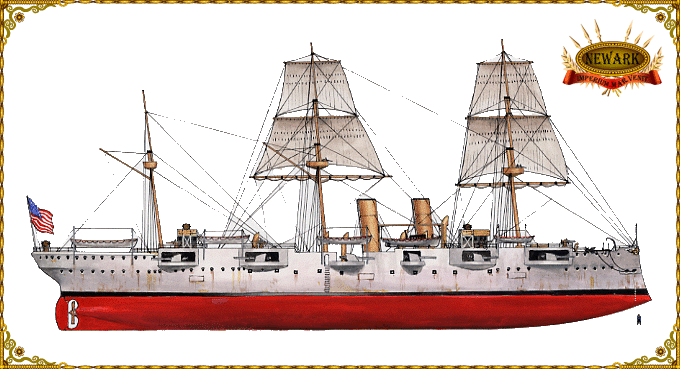
USS Newark as built, 1899, showing her rigging (both illustrations by the author)

USS Newark’s Appareance in 1901
Read More
https://en.wikipedia.org/wiki/USS_Newark_(C-1)
Conway’s all the world’s fighting ships 1865-1906
3D model

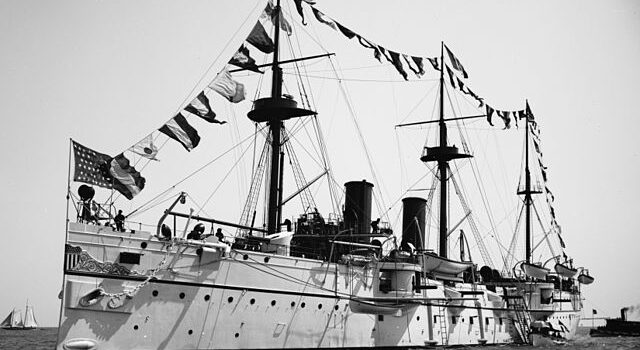

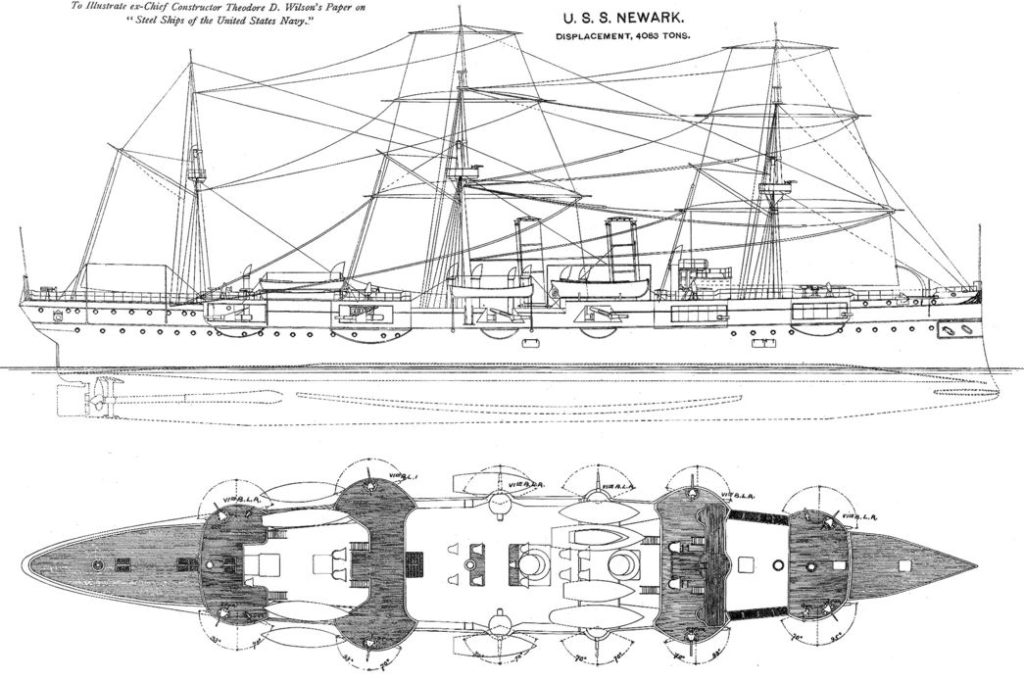
 Latest Facebook Entry -
Latest Facebook Entry -  X(Tweeter) Naval Encyclopedia's deck archive
X(Tweeter) Naval Encyclopedia's deck archive Instagram (@navalencyc)
Instagram (@navalencyc)





 French Navy
French Navy Royal Navy
Royal Navy Russian Navy
Russian Navy Armada Espanola
Armada Espanola Austrian Navy
Austrian Navy K.u.K. Kriegsmarine
K.u.K. Kriegsmarine Dansk Marine
Dansk Marine Nautiko Hellenon
Nautiko Hellenon Koninklije Marine 1870
Koninklije Marine 1870 Marinha do Brasil
Marinha do Brasil Osmanlı Donanması
Osmanlı Donanması Marina Do Peru
Marina Do Peru Marinha do Portugal
Marinha do Portugal Regia Marina 1870
Regia Marina 1870 Nihhon Kaigun 1870
Nihhon Kaigun 1870 Preußische Marine 1870
Preußische Marine 1870 Russkiy Flot 1870
Russkiy Flot 1870 Svenska marinen
Svenska marinen Søværnet
Søværnet Union Navy
Union Navy Confederate Navy
Confederate Navy Armada de Argentina
Armada de Argentina Imperial Chinese Navy
Imperial Chinese Navy Marinha do Portugal
Marinha do Portugal Mexico
Mexico Kaiserliche Marine
Kaiserliche Marine 1898 US Navy
1898 US Navy Sovietskiy Flot
Sovietskiy Flot Royal Canadian Navy
Royal Canadian Navy Royal Australian Navy
Royal Australian Navy RNZN Fleet
RNZN Fleet Chinese Navy 1937
Chinese Navy 1937 Kriegsmarine
Kriegsmarine Chilean Navy
Chilean Navy Danish Navy
Danish Navy Finnish Navy
Finnish Navy Hellenic Navy
Hellenic Navy Polish Navy
Polish Navy Romanian Navy
Romanian Navy Turkish Navy
Turkish Navy Royal Yugoslav Navy
Royal Yugoslav Navy Royal Thai Navy
Royal Thai Navy Minor Navies
Minor Navies Albania
Albania Austria
Austria Belgium
Belgium Columbia
Columbia Costa Rica
Costa Rica Cuba
Cuba Czechoslovakia
Czechoslovakia Dominican Republic
Dominican Republic Haiti
Haiti Hungary
Hungary Honduras
Honduras Estonia
Estonia Iceland
Iceland Eire
Eire Equador
Equador Iran
Iran Iraq
Iraq Latvia
Latvia Liberia
Liberia Lithuania
Lithuania Mandchukuo
Mandchukuo Morocco
Morocco Nicaragua
Nicaragua Persia
Persia San Salvador
San Salvador Sarawak
Sarawak Uruguay
Uruguay Venezuela
Venezuela Zanzibar
Zanzibar Warsaw Pact Navies
Warsaw Pact Navies Bulgaria
Bulgaria Hungary
Hungary

 Bundesmarine
Bundesmarine Dutch Navy
Dutch Navy Hellenic Navy
Hellenic Navy Marina Militare
Marina Militare Yugoslav Navy
Yugoslav Navy Chinese Navy
Chinese Navy Indian Navy
Indian Navy Indonesian Navy
Indonesian Navy JMSDF
JMSDF North Korean Navy
North Korean Navy Pakistani Navy
Pakistani Navy Philippines Navy
Philippines Navy ROKN
ROKN Rep. of Singapore Navy
Rep. of Singapore Navy Taiwanese Navy
Taiwanese Navy IDF Navy
IDF Navy Saudi Navy
Saudi Navy Royal New Zealand Navy
Royal New Zealand Navy Egyptian Navy
Egyptian Navy South African Navy
South African Navy






























 Ukrainian Navy
Ukrainian Navy dbodesign
dbodesign